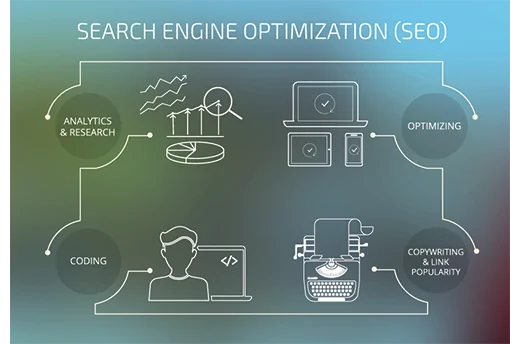Do you know how to optimize content for SEO?
Optimizing content for SEO (Search Engine Optimization) involves several key strategies to ensure your content ranks well in search engine results pages (SERPs) and attracts organic traffic.

How to Optimize Content for SEO
Here are some steps you can take to optimize your content for SEO:
Keyword Research
Keyword research is a fundamental aspect of search engine optimization (SEO) that involves identifying relevant keywords and phrases your target audience is searching for. By understanding the specific terms people use when searching for information, products, or services related to your business, you can tailor your content to match these search queries, thereby improving your chances of ranking higher in search engine results pages (SERPs) and attracting organic traffic to your website.
Furthermore, various tools, including Google Keyword Planner, SEMrush, and Ahrefs, can help you conduct keyword research effectively. These tools provide valuable insights into keyword trends, search volume, competition levels, and related terms, helping you discover high-value keywords to target in your content.
Google Keyword Planner
Google Keyword Planner, for instance, is a free tool provided by Google Ads that allows you to explore keyword ideas and estimate their search volumes. By entering relevant keywords or phrases related to your business or industry, you can generate a list of keyword suggestions along with their average monthly search volumes and level of competition. This information helps you prioritize which keywords to target based on their search volume and competitiveness.
SEMrush and Ahrefs
SEMrush and Ahrefs are more comprehensive SEO tools that offer advanced keyword research features. They provide data on keyword difficulty, search volume trends over time, related keywords, and competitor analysis. These tools enable you to identify high-volume and long-tail keywords—more specific and less competitive phrases—that can be valuable for targeting niche audiences.
When conducting keyword research, it’s essential to consider both the search volume and the level of competition for each keyword. High-volume keywords may attract more traffic, but they also tend to have higher competition, making it harder to rank for them. Conversely, low-volume keywords may have less competition but may not generate as much traffic. Therefore, finding the right balance between search volume and competition is crucial.
Long-tail Keywords
Long-tail keywords are precious in this regard. These longer, more specific phrases often indicate stronger user intent and can lead to higher conversion rates. For example, instead of targeting a broad keyword like “digital marketing,” you might target a long-tail keyword like “best digital marketing strategies for small businesses.” While the search volume for the latter may be lower, it’s likely to attract more qualified leads specifically interested in your offerings.
In addition to search volume and competition, consider the keywords’ relevance to your target audience and content. Choose keywords that accurately reflect the topic of your content and align with the searcher’s intent. It ensures that your content addresses the needs and interests of your audience, which can ultimately lead to higher engagement and better rankings in search results.
Once you’ve identified your target keywords, incorporate them strategically into your content, including in titles, headings, meta tags, and throughout the body of the text. However, avoid keyword stuffing—overloading your content with keywords in an unnatural way—which can harm your SEO efforts and make your content less appealing to readers.
Content Planning
Content planning is crucial for effective SEO. Once you’ve identified relevant keywords, creating content that aligns with them is essential. Develop a content plan with topics and formats tailored to resonate with your audience. Consider the preferences and interests of your target audience when selecting topics and formats such as blog posts, videos, infographics, and more. For example, if your keyword research reveals a high demand for “best digital marketing strategies,” you could plan blog posts detailing effective strategies, create videos demonstrating implementation, and design infographics summarizing key points.
By aligning your content with identified keywords and audience preferences, you can increase the likelihood of ranking well in search results and effectively engaging your target audience. This strategic approach to content planning ensures that your efforts are focused on delivering valuable content that meets the needs of your audience while driving organic traffic to your website.

On-Page Optimization
- Title Tag: Include your target keyword in the title tag, preferably near the beginning.
- Meta Description: Write a compelling meta description that includes the keyword and entices users to click.
- Headings (H1, H2, etc.): Use headings to structure your content and include relevant keywords where appropriate.
- URL Structure: Keep URLs short and descriptive, and include the target keyword if possible
- Keyword Placement: Naturally incorporate keywords throughout the content, including in the first paragraph and subheadings
- Optimize Images: Use descriptive file names and alt text for images, including keywords where relevant.
Quality Content
Creating high-quality, valuable content is essential when it comes on how to optimize content for SEO. Your content should address the needs and interests of your target audience while aligning with the keywords you’re targeting. It must be informative, engaging, and relevant to ensure it resonates with your audience and provides value. Whether you’re writing blog posts, producing videos, or designing infographics, focus on delivering content that answers questions, solves problems, or provides valuable insights related to your chosen keywords.
By offering informative and engaging content, you can establish yourself as an authority in your field, build trust with your audience, and encourage them to return for more. Remember, quality content improves your SEO by attracting organic traffic and enhances user experience, leading to better engagement and higher conversion rates. So, prioritize quality when creating content to maximize its impact on your SEO efforts.
Mobile Optimization
Ensure your website is mobile-friendly, as Google prioritizes mobile-friendly websites in its search results. Test your site using Google’s Mobile-Friendly Test tool.
Page Speed
Page Speed is also essential on how to optimize your content for SEO. Improve your website’s loading speed to enhance user experience and SEO rankings. Use tools like Google Page Speed Insights to identify and fix speed issues.
Internal and External Links
Internal and external links play vital roles in SEO. The internal links connect your content to other relevant pages, improving navigation and helping search engines understand your site’s structure. By strategically including internal links, you guide visitors to more of your content, enhancing their experience and keeping them engaged longer. Additionally, internal linking distributes link equity across your site, boosting the authority of essential pages and improving their rankings in search results.
On the other hand, external links to reputable sources provide further value to your readers by offering additional information or context. These authoritative links also signal to search engines that your content is well-researched and credible, which can positively impact your site’s SEO. You can enhance your website’s usability, credibility, and search engine visibility by thoughtfully incorporating internal and external links.
Social Sharing
Social sharing also plays a vital role in how to optimize your content SEO. Encouraging social sharing of your content is a powerful strategy for boosting visibility and attracting more traffic to your website. Sharing your content on social media platforms like Facebook, Twitter, and LinkedIn reaches a broader audience. It has the potential to go viral, driving more visitors to your site. Additionally, social signals—such as likes, shares, and comments—send positive signals to search engines about the quality and relevance of your content, indirectly impacting SEO rankings.
To encourage social sharing, make your content easily shareable by adding social sharing buttons to your website and creating engaging, share-worthy content that resonates with your audience. Encourage your followers to share your content by asking questions, running social media contests, or offering incentives for sharing. By leveraging social sharing effectively, you can increase your content’s reach, attract more visitors, and improve your site’s SEO performance.
Schema Markup
Implementing schema markup is a valuable strategy on how to optimize content for SEO. It provides search engines with additional context about your content. This enhances your listings in SERPs with rich snippets, which are extra information displayed alongside your search results, such as star ratings, reviews, and event details. Rich snippets make your listing more visually appealing and informative.
Furthermore, by incorporating schema markup into your website’s code, you enable search engines to understand the content of your pages better, improving their chances of being displayed prominently in search results. It can result in higher click-through rates and increased visibility for your website. Schema markup can be applied to various types of content, including articles, products, events, and reviews. By taking advantage of schema markup, you can make your website stand out in search results and provide users with more relevant and engaging information.

Regular Updates
Regularly updating and refreshing your content is crucial to a successful SEO strategy. Keep your content fresh and relevant, signal to search engines that your website is active, and continually provide value to users.
Search engines like Google prioritize websites that frequently update their content because it indicates that the information provided is current and trustworthy. When you regularly update your content, search engine crawlers will likely revisit your website to index the new information. This can lead to more frequent indexing, positively impacting your rankings in search results.
Furthermore, updating and repurposing older posts can breathe new life into your content and attract additional traffic. Over time, specific topics may become outdated or require further information, so revisiting and updating older posts ensures they remain relevant and accurate.
Repurposing Content
Repurposing content involves presenting existing content in a new format or with additional insights. For example, you could turn a blog post into a video, create an infographic summarizing key points, or expand on a topic in a new blog post. It provides value to your audience and allows you to target different keywords and reach new audiences.
Additionally, regularly updating your content can improve user experience. When users find accurate and up-to-date information on your website, they are more likely to trust your brand and return for future visits. It can lead to increased engagement, longer time spent on your site, and higher conversion rates.
To update your content effectively, identify older posts that may benefit from refreshment or expansion. Look for topics that are still relevant but could use additional information or a new perspective. Update statistics, add recent examples, and include links to more recent content where appropriate.
Reviewing your content for outdated information or broken links and making necessary corrections is also essential. Additionally, consider optimizing your content for current SEO best practices, including relevant keywords, improving readability, and optimizing meta tags.
Analytics and Monitoring
Analytics and monitoring are crucial to any successful SEO strategy. Using tools like Google Analytics and Google Search Console, you can gain valuable insights into your website’s performance, track keyword rankings, and identify areas for improvement.
Google Analytics

Google Analytics provides detailed data about your website’s traffic, including the number of visitors, their demographics, behavior, and interactions with your site. This information helps you understand how users find and interact with your content, allowing you to make data-driven decisions to optimize your website.
For instance, you can track the most popular pages, how users navigate your site, and which sources drive the most traffic. This insight enables you to identify high-performing content, optimize conversion paths, and focus on channels that generate the most traffic.
Google Search Console
Google Search Console complements Google Analytics by providing specific data about your website’s presence in Google search results. It allows you to monitor your site’s indexing status, submit sitemaps, and identify technical issues affecting your SEO performance. One of the most valuable features of Google Search Console is the ability to track keyword rankings. You can see which keywords your site ranks for, their average position, and the click-through rate. This data helps you understand your content’s performance in search results and identify opportunities to improve rankings.
By monitoring keyword rankings, you can identify keywords where your site ranks on the second or third page of search results, indicating opportunities to optimize content for SEO and improve its visibility. You can also identify high-ranking keywords with low click-through rates, indicating opportunities to optimize meta tags and improve snippet appearance.
Furthermore, analytics and monitoring are essential for optimizing your website for search engines. Using tools like Google Analytics and Google Search Console, you can gain valuable insights into your website’s performance. You can also track keyword rankings and identify areas for improvement. This data-driven approach allows you to make informed decisions about optimizing your website. It can improve its visibility in search results and drive more organic traffic.
These SEO optimization techniques can increase your content’s visibility in search engine results and attract organic traffic to your website. Remember that SEO is an ongoing process, so monitor, analyze, and adapt your strategies to stay ahead of the competition.

 Create Valuable and Unique Content: Focus on creating high-quality, original content that provides value to users and distinguishes your website from competitors.
Create Valuable and Unique Content: Focus on creating high-quality, original content that provides value to users and distinguishes your website from competitors.

